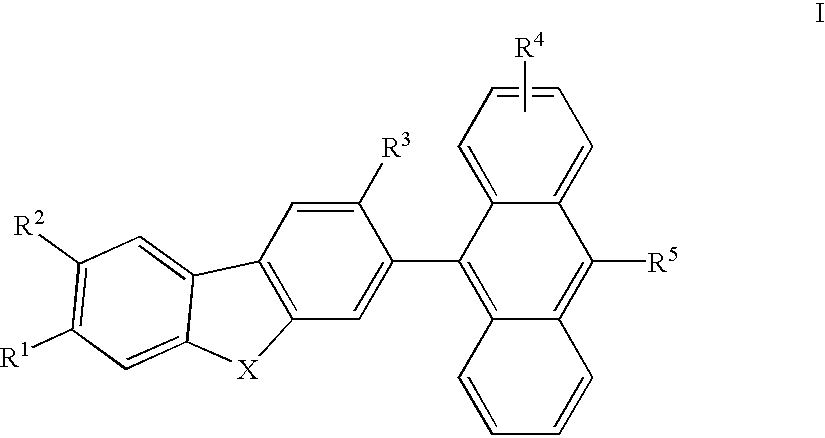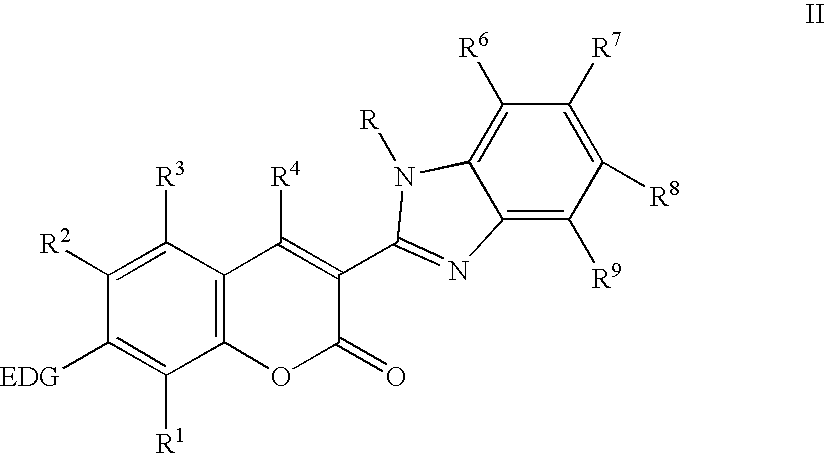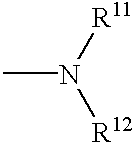Electroluminescent devices
a technology of electroluminescent devices and electrodes, applied in the direction of discharge tube luminescnet screens, organic semiconductor devices, natural mineral layered products, etc., to achieve the effect of long operation stability and high fluorescent intensity
- Summary
- Abstract
- Description
- Claims
- Application Information
AI Technical Summary
Benefits of technology
Problems solved by technology
Method used
Image
Examples
example 1
Synthesis of 9,9-Diethylfluorene
[0103] To a mechanically stirred mixture of fluorine (83.2 g. 0.5 mol.), powdered potassium hydroxide (140 g., 2.5 mol.), potassium iodide (4.0 g., 0.024 mol.) and DMSO (225 ml), cooled to 15-20.degree. C., bromoethane (104 ml., 151.84 g., 1.39 mol.) was added over a period of 1.5 hours, and allowed to stir at room temperature overnight. The mixture was diluted with water (1200 ml), and extracted with toluene (2.times.400 ml). The toluene extract was washed with water, dried and concentrated to get 116.66 g., of a red oil. This was distilled at 1.2 mm, b.p. 125.degree. C. to get a colorless oil, that solidified, 104.32 g., (94% yield).
example 2
Synthesis of 2-Bromo-9,9-diethylfluorene
[0104] To a solution of diethylfluorene (22.2 g., 0.1 mol.) in propylene carbonate (100 ml), N-bromosuccinimide (17.8 g., 0.1 mol.) was added at 57.degree. C. in portions and the mixture was stirred for 30 minutes at 60.degree. C. The mixture was diluted with 1200 ml of water and extracted with 500 ml of toluene. The toluene extract was washed 3 times with 300 ml portions of water, dried and concentrated. The crude product from 3 batches of the same size totaled 117 g. oil. This was distilled at 2 mm. The first fraction, b.p. 90-93.degree. C., 22.33 g., was found to be propylene carbonate. The second fraction, b. p. 155-165.degree. C., 81.0 g. (89.7% yield), was the desired compound.
example 3
Synthesis of 9,9-diethylfluorenyl-2-boronic Acid
[0105] A solution of n-BuLi (1.6 M in hexane, 100 mL, 0.16 mol) was added via an addition funnel to 2-bromo-9,9-diethylfluorene prepared by example 2 (42.0 g, 0.14 mol) in 200 mL of dry THF at -78 C. The yellow suspension was stirred at this temperature for a half hour, a solution of B(OMe).sub.3 (26.6 mL, 29.1 g, 0.28 mol) in 150 mL of dry THF was added dropwise, with the temperature kept below -60.degree. C. The resulting colorless solution was allowed to warm to room temperature 2 hour, then 300 mL of 5 M HCl was added and the mixture stirred for a further one hour under nitrogen. Water and ether were added, and the aqueous layer was extracted several times with ether. The combined organic extracts were dried over MgSO4 and evaporated under reduced pressure to yield a white solid (34.0 g, 95%), which was used in the coupling reaction without further purification.
PUM
| Property | Measurement | Unit |
|---|---|---|
| excitation voltages | aaaaa | aaaaa |
| thickness | aaaaa | aaaaa |
| thickness | aaaaa | aaaaa |
Abstract
Description
Claims
Application Information
 Login to View More
Login to View More - R&D
- Intellectual Property
- Life Sciences
- Materials
- Tech Scout
- Unparalleled Data Quality
- Higher Quality Content
- 60% Fewer Hallucinations
Browse by: Latest US Patents, China's latest patents, Technical Efficacy Thesaurus, Application Domain, Technology Topic, Popular Technical Reports.
© 2025 PatSnap. All rights reserved.Legal|Privacy policy|Modern Slavery Act Transparency Statement|Sitemap|About US| Contact US: help@patsnap.com



